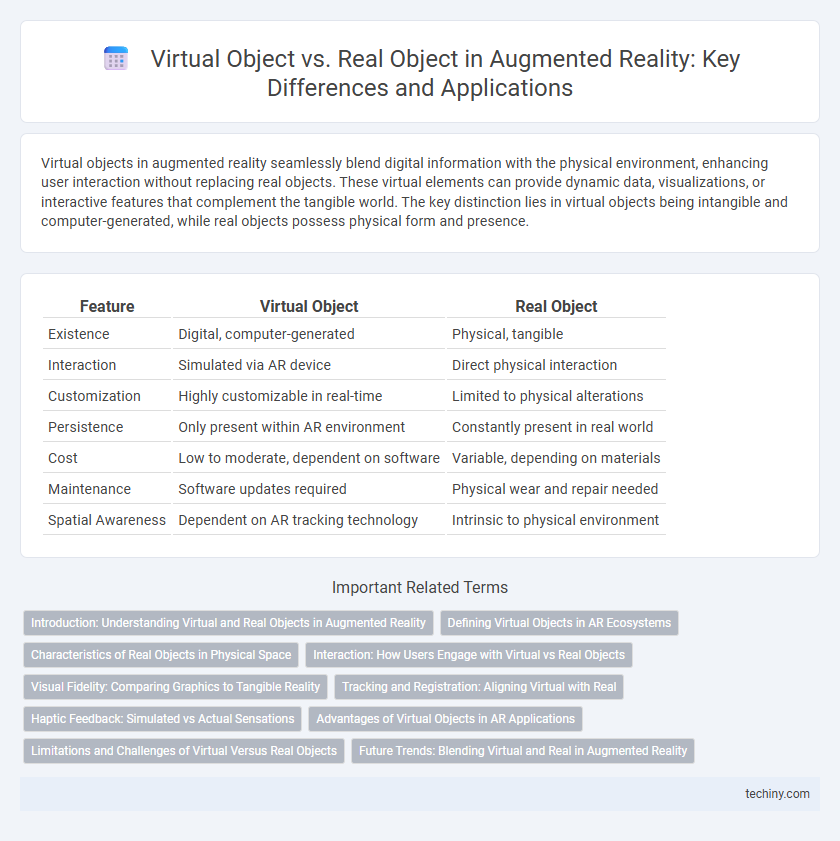Virtual objects in augmented reality seamlessly blend digital information with the physical environment, enhancing user interaction without replacing real objects. These virtual elements can provide dynamic data, visualizations, or interactive features that complement the tangible world. The key distinction lies in virtual objects being intangible and computer-generated, while real objects possess physical form and presence.
Table of Comparison
| Feature | Virtual Object | Real Object |
|---|---|---|
| Existence | Digital, computer-generated | Physical, tangible |
| Interaction | Simulated via AR device | Direct physical interaction |
| Customization | Highly customizable in real-time | Limited to physical alterations |
| Persistence | Only present within AR environment | Constantly present in real world |
| Cost | Low to moderate, dependent on software | Variable, depending on materials |
| Maintenance | Software updates required | Physical wear and repair needed |
| Spatial Awareness | Dependent on AR tracking technology | Intrinsic to physical environment |
Introduction: Understanding Virtual and Real Objects in Augmented Reality
Virtual objects in augmented reality are computer-generated elements seamlessly integrated into the user's real-world environment, enhancing perception through interactive visual overlays. Real objects exist physically in the environment and serve as reference points or interaction anchors for virtual elements, enabling spatial coherence and user engagement. Understanding the distinction and interaction between virtual and real objects is fundamental for designing intuitive AR experiences that blend digital content with tangible surroundings.
Defining Virtual Objects in AR Ecosystems
Virtual objects in augmented reality (AR) ecosystems are digitally created entities that seamlessly integrate with the physical environment through AR devices, enhancing user perception and interaction. These objects are defined by their ability to maintain spatial consistency and respond dynamically to real-world inputs, enabling immersive and context-aware experiences. Unlike real objects, virtual objects exist solely within the AR framework, relying on advanced computer vision, spatial mapping, and real-time rendering technologies to blend into the user's physical surroundings.
Characteristics of Real Objects in Physical Space
Real objects possess inherent physical properties such as mass, texture, temperature, and solidity that affect user interaction and perception. They occupy tangible space with consistent dimensions and respond naturally to environmental factors like lighting, gravity, and physical forces. These characteristics enable precise tactile feedback and spatial awareness, which augmented reality seeks to replicate or enhance with virtual counterparts.
Interaction: How Users Engage with Virtual vs Real Objects
Users interact with virtual objects in augmented reality through intuitive gestures, eye tracking, and haptic feedback, enabling immersive manipulation beyond physical constraints. Real objects provide tangible sensory input such as texture, weight, and temperature, fostering direct physical engagement and spatial awareness. The integration of virtual objects with real-world environments enhances interaction by blending digital flexibility with the natural physicality of real objects.
Visual Fidelity: Comparing Graphics to Tangible Reality
Virtual objects in augmented reality often strive for high visual fidelity through advanced rendering techniques like ray tracing and physically based shading to mimic real-world lighting and textures. However, discrepancies in resolution, depth perception, and occlusion handling can reveal the artificial nature of digital content compared to tangible reality. Ensuring seamless integration requires optimizing frame rates and color accuracy to enhance the user's perception of virtual objects as realistic counterparts within their physical environment.
Tracking and Registration: Aligning Virtual with Real
Accurate tracking systems such as simultaneous localization and mapping (SLAM) enable the precise alignment of virtual objects with real-world environments by continuously monitoring user movements and spatial changes. Registration techniques utilize sensor data, including depth cameras and inertial measurement units (IMUs), to overlay virtual content seamlessly onto real objects, maintaining consistent positioning and orientation. Advanced algorithms correct for latency and spatial drift, ensuring that virtual objects remain properly anchored and synchronized with their real-world counterparts during interaction.
Haptic Feedback: Simulated vs Actual Sensations
Haptic feedback in augmented reality distinguishes virtual objects from real objects by simulating touch sensations through vibrations or force feedback devices, enhancing user interaction without physical presence. Actual sensations from real objects provide authentic tactile experiences, including texture, temperature, and resistance, which current AR haptics strive to replicate but cannot fully match. Advances in haptic technology aim to minimize this sensory gap, integrating more precise force feedback and multisensory cues to improve the realism of virtual object interaction.
Advantages of Virtual Objects in AR Applications
Virtual objects in augmented reality provide unparalleled flexibility by allowing dynamic interaction and modification without physical constraints, enhancing user engagement. They enable cost-effective prototyping and visualization in fields such as architecture and design, reducing the need for tangible materials. Moreover, virtual objects can be seamlessly integrated with real-world environments, offering enhanced contextual information and immersive experiences that real objects cannot match.
Limitations and Challenges of Virtual Versus Real Objects
Virtual objects in augmented reality face limitations such as lack of tactile feedback and imperfect spatial alignment compared to real objects, leading to reduced user interaction fidelity. Rendering latency and occlusion challenges hinder seamless integration of virtual content into dynamic real-world environments. Furthermore, differences in physical properties like weight and texture create hurdles in replicating realistic sensory experiences for virtual objects.
Future Trends: Blending Virtual and Real in Augmented Reality
Future trends in augmented reality emphasize seamless integration of virtual objects with real-world environments through advanced spatial mapping and AI-driven context awareness. Enhanced photorealistic rendering and dynamic interaction capabilities enable virtual elements to adapt fluidly to physical surroundings, creating immersive, indistinguishable experiences. Emerging technologies such as 5G and edge computing support real-time processing, further bridging the gap between virtual and real objects in AR applications.
Virtual Object vs Real Object Infographic

 techiny.com
techiny.com